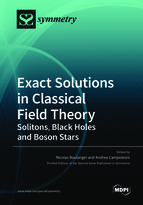Exact Solutions in Classical Field Theory: Solitons, Black Holes and Boson Stars
A special issue of Symmetry (ISSN 2073-8994). This special issue belongs to the section "Physics".
Deadline for manuscript submissions: closed (20 November 2020) | Viewed by 12929
Special Issue Editors
Interests: higher spin gauge theories; supergravity and duality; fractional spin fields and anyons; BRST-BV formalism; weyl invariance in gravity; poisson sigma models; AKSZ quantization; AdS/CFT
Special Issues, Collections and Topics in MDPI journals
Special Issue Information
Dear Colleagues,
Compact objects is the name given to solutions in General Relativity (or alternative models of gravity) that are typically so dense that the curvature of space–time around them has detectable effects. An extreme case exists, which is realized and observed in Nature: Black Holes. There exists at least one alternative to black holes, albeit more exotic, given by compact objects made out of bosonic fields, the simplest example being the boson star made of a complex valued, massive scalar field.
The study of compact objects as dense as black holes and boson stars is interesting in its own right. It is also very important from another perspective: Since these objects create very strong gravitational fields, they also are an ideal testing ground for alternative models of gravity and/or for testing the limits of General Relativity. The latter theory works extremely well in the weak regime but has not been explored in full detail in the very strong regime. This Special Issue is dedicated to exact solutions to Einstein–Yang–Mills-type theories and their various extensions.
Prof. Dr. Nicolas BoulangerDr. Andrea Campoleoni
Guest Editors
Manuscript Submission Information
Manuscripts should be submitted online at www.mdpi.com by registering and logging in to this website. Once you are registered, click here to go to the submission form. Manuscripts can be submitted until the deadline. All submissions that pass pre-check are peer-reviewed. Accepted papers will be published continuously in the journal (as soon as accepted) and will be listed together on the special issue website. Research articles, review articles as well as short communications are invited. For planned papers, a title and short abstract (about 100 words) can be sent to the Editorial Office for announcement on this website.
Submitted manuscripts should not have been published previously, nor be under consideration for publication elsewhere (except conference proceedings papers). All manuscripts are thoroughly refereed through a single-blind peer-review process. A guide for authors and other relevant information for submission of manuscripts is available on the Instructions for Authors page. Symmetry is an international peer-reviewed open access monthly journal published by MDPI.
Please visit the Instructions for Authors page before submitting a manuscript. The Article Processing Charge (APC) for publication in this open access journal is 2400 CHF (Swiss Francs). Submitted papers should be well formatted and use good English. Authors may use MDPI's English editing service prior to publication or during author revisions.







